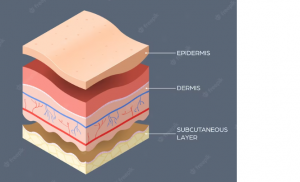The skin and how it works
Mailén Agüero – Business Development Analyst
Francisco Stefano – Director
The skin not only plays a physical defense role but also has immune, metabolic and ultraviolet protection functions.
The skin is the largest organ and outermost tissue of the human body, together with nails, hair and glands form the integumentary system. It has a barrier function. On the one hand, it can prevent the action of harmful factors present in the environment such as mechanical, chemical, physical or biological, it also prevents loss of nutrients, electrolytes and water in the body. Also has endocrine functions such as the production of vitamin D converting 7-dehydrocholesterol in the epidermis to vitamin D, with the assistance of UV light from the sun.
Three layers of tissue make up the skin:
Epidermis
The epidermis is the top layer of the skin that you can see and touch. It is a patchwork of cells and its thickness depends of its location in the body, There are three main cells in the epidermis, the Keratinocytes, Melanocytes and Langerhans cells. The Keratocytes are the prevailing cells, they develop in the basal layer of the epidermis and migrate upwards to the outer surface forming the stratum corneum, a dense layer of cells that limit the passage of water and chemicals.
The epidermis:
- Acts as a protective barrier
- Makes new skin
- Protects your body
- Provides skin color
Dermis
The dermis makes up 90% of the skin’s thickness. This middle layer of skin:
- Has collagen and elastin
- Grows hair
- Produces oil and sweat
- Supplies blood
Hypodermis
The bottom layer of skin, or hypodermis, is the fatty layer. The hypodermis:
- Cushions muscles and bones
- Has connective tissue
- Helps the nerves and blood vessels
- Regulates body temperature
The skin and Transdermal drug delivery systems
There are two ways of drug absorption through the skin: one way is to enter the dermis through the stratum corneum and epidermis and is absorbed by capillaries into the systemic circulation, that is, the epidermal route. This is the main way for the drug to be absorbed through the skin. In this way, the drug can pass through the stratum corneum cells to reach the active epidermis, or through the interstitial spaces of the stratum corneum to reach the active epidermis. Due to the large diffusion resistance of stratum corneum cells, drug molecules diffuse through the stratum corneum mainly through the intercellular space.
The other way is absorption through skin appendages, hair follicles, sebaceous glands and sweat glands. The penetration rate of drugs through the skin appendages is faster than through the stratum corneum, but the skin appendages occupy only about 0.1% of the skin surface area, so it is generally considered that it is not the primary way of drug absorption through the skin.
When transdermal penetration begins, the drug is first absorbed through the skin adnexal QUEDA adnexal pathway. When the drug reaches the blood circulation through the epidermal route, the percutaneous penetration reaches a steady state, and the effect of the adnexal route can be ignored. When the drug formulation is applied to the skin, the drug is released from the formulation to the skin surface. The drug dissolved on the skin surface is distributed into the stratum corneum, diffuses through the stratum corneum to reach the aqueous active epidermis, continues to diffuse to the dermis, and is absorbed by capillaries into the human circulation. The lipid-rich stratum corneum is the main barrier during the entire diffusion process.
Subscribe to
#AmarinNews
Partner with us!
We offer expertise and experience, together with flexibility and the ability to adapt to your needs.
- info@amarintech.com.ar
- +54 11 4588-6500
- Sanchez 2045 (C1416BQG), Buenos Aires, Argentina.


